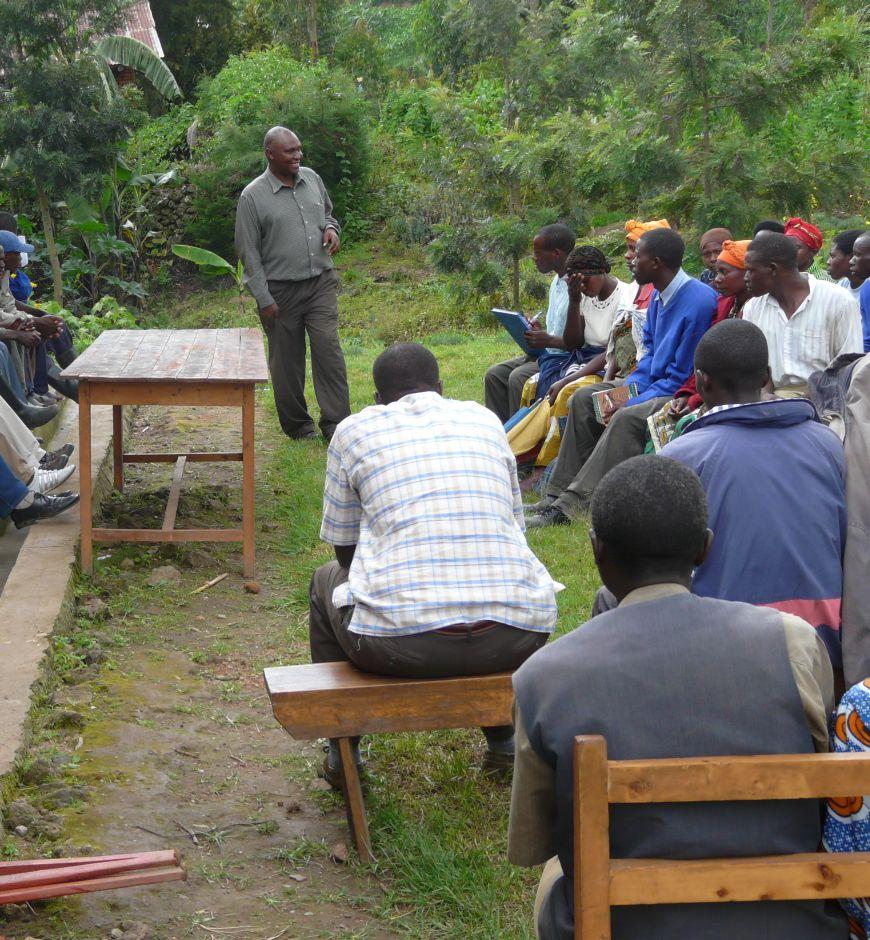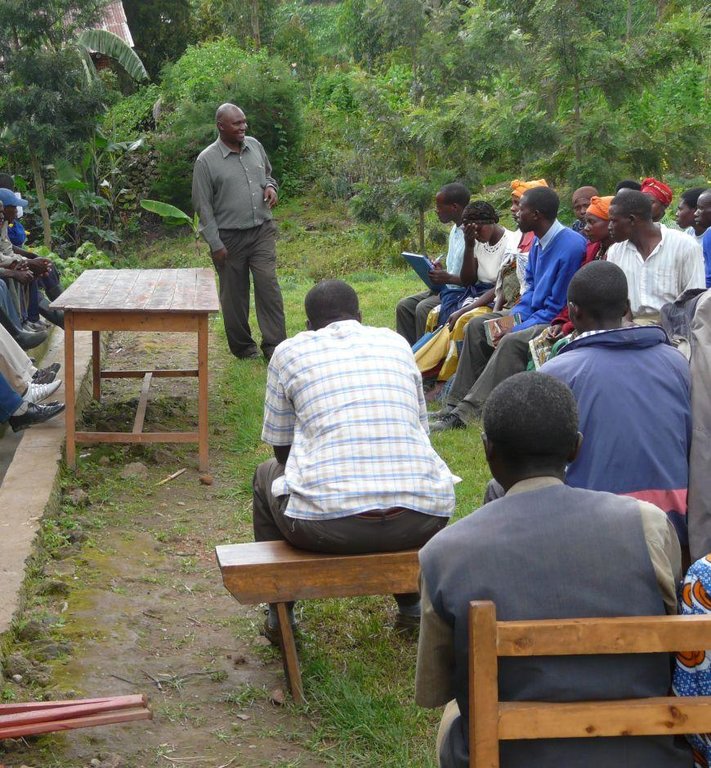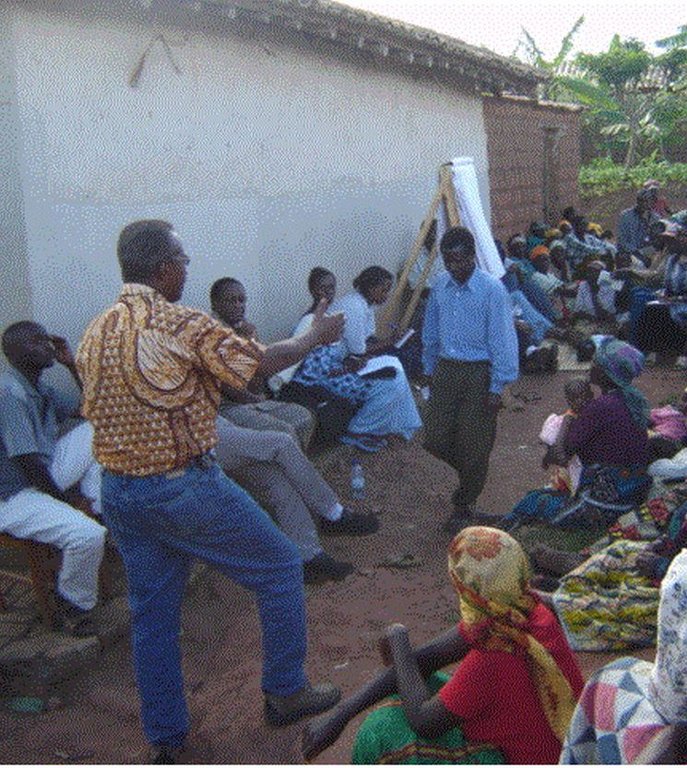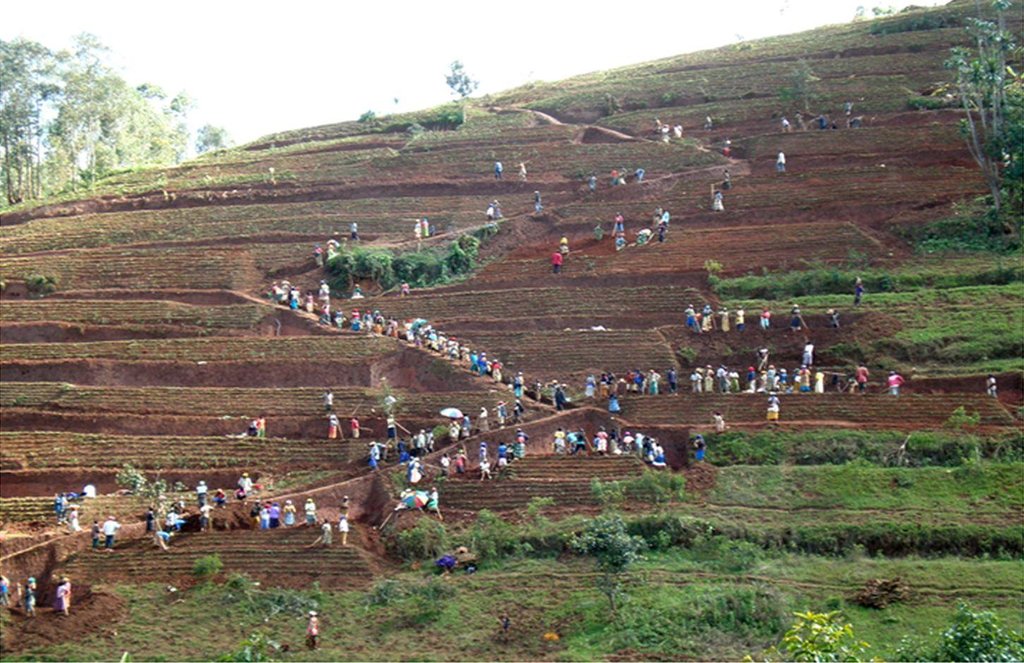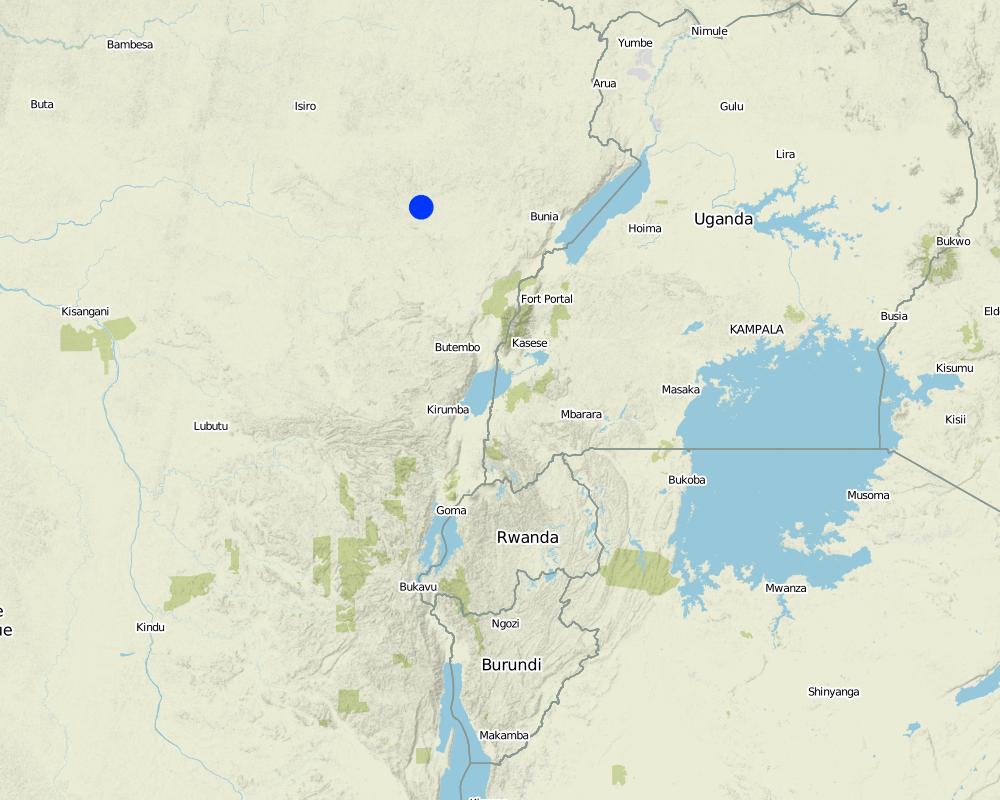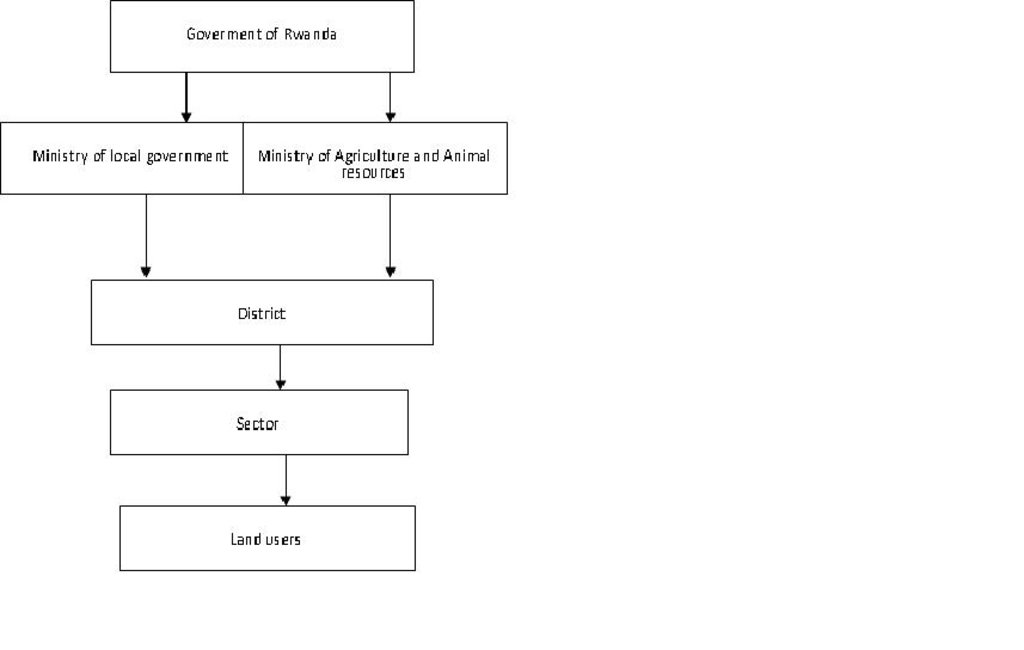Top down approach [รวันดา]
- ผู้สร้างสรรค์:
- การอัพเดท:
- ผู้รวบรวม: Desire Kagabo
- ผู้เรียบเรียง: –
- ผู้ตรวจสอบ: David Streiff
Amabwiriza aturutse ibukuru
approaches_2465 - รวันดา
ดูส่วนย่อย
ขยายทั้งหมด ย่อทั้งหมด1. ข้อมูลทั่วไป
1.2 รายละเอียดที่ติดต่อได้ของผู้รวบรวมและองค์กรที่เกี่ยวข้องในการประเมินและการจัดเตรียมทำเอกสารของแนวทาง
ผู้เชี่ยวชาญ SLM:
ชื่อของโครงการซึ่งอำนวยความสะดวกในการทำเอกสารหรือการประเมินแนวทาง (ถ้าเกี่ยวข้อง)
The Transboundary Agro-ecosystem Management Project for the Kagera River Basin (GEF-FAO / Kagera TAMP )1.3 เงื่อนไขที่เกี่ยวข้องกับการใช้ข้อมูลที่ได้บันทึกไว้ผ่านทาง WOCAT
วันที่เก็บรวบรวมข้อมูล (ภาคสนาม):
01/01/2011
ผู้รวบรวมและวิทยากรหลักยอมรับเงื่อนไขเกี่ยวกับการใช้ข้อมูลที่ถูกบันทึกผ่านทาง WOCAT:
ใช่
1.4 การอ้างอิงถึงแบบสอบถามเรื่องเทคโนโลยี SLM
2. คำอธิบายของแนวทาง SLM
2.1 การอธิบายแบบสั้น ๆ ของแนวทาง
This is a top down approach to technology development and dissemination with limited involvement of intended beneficiaries.
2.2 การอธิบายอย่างละเอียดของแนวทาง
การอธิบายอย่างละเอียดของแนวทาง:
Aims / objectives: The objective of the top down approach is to assign the state a crucial role to drive a designed rural development and land management master plan that needs people to implement it.
To bring farmers together to address an identified problem such as to improve the socio economic situation of rural areas, to prevent , to conserve and to rehabilitate on-site damages caused by land degradation and erosion.
Methods: The top down approach here refers to the level of farmer participation in relation to shared decision making when establishing bench terraces/soil conservation practices in Rwanda. The focus being particularly on the role of farmers in the decision making process during two major phases of the process of terrace construction including: (1) when and where to construct bench terraces in communities and the criteria for site and beneficiary selection. The level of farmer participation and decision sharing have the potential of in increasing the ownership of the of the existing or future bench terraces, hence to ensure its sustainability. Recent studies assert that most of the terraces that are constructed are supply driven and that farmers do not participate in the decisions regarding where and when to construct them. When farmers do participate, it is mostly only through some consultation and their own efforts to mobilize collective labor for the construction of the terraces.
Stages of implementation: Stage one comprises the analysis of current or initial adoption decisions of soil conservation practices, while stage two assesses farmers’ ability to continue the use of these practices. Stage three analyses future adoption proxied by farmers’ willingness to uptake more soil conservation practices.
Role of stakeholders: The state plays a prime role in bench terraces development and the role of other stakeholders (e.g. extension agents, farmer associations) is marginal. Farmer associations involvement is is limited to mobilizing labor and, sometimes, to identifying land for terracing. Extension agencies/services are involved in providing advice to individual farmers or farmers grouped in cooperatives. Community representatives, whom are members of the farmers’ cooperatives themselves, are trained to provide additional support and advice to farmers.
Other important information: This SLM approach argues for a role of the state with top-down and coercive measures in the development of soil conservation practices, particularly bench terraces. Currently there is a two pronged approach based on the realization that bench terraces are ready made constructions which require substantial financial and institutional investments. Mustering labor and resources for the construction and maintenance of bench terraces remains a key aspect of the state’s conservation drive. State-farmer relationships, therefore, continue to be essential to soil conservation efforts in Rwanda and to bench terrace construction in particular.
2.3 รูปภาพของแนวทาง
2.5 ประเทศ ภูมิภาค หรือสถานที่ตั้งที่ได้นำแนวทางไปใช้
ประเทศ:
รวันดา
ภูมิภาค/รัฐ/จังหวัด: :
East
ข้อมูลเฉพาะเพิ่มเติมของสถานที่ตั้ง:
Kayonza
ความคิดเห็น:
The area is not well known, it is approximately estimated
Map
×2.6 วันที่เริ่มต้นและสิ้นสุดของแนวทาง
ระบุปีที่เริ่ม:
1950
2.7 ประเภทของแนวทาง
- government based
2.8 เป้าหมายหรือวัตถุประสงค์หลักของแนวทาง
The Approach focused mainly on SLM with other activities (Increase soil fertility, good practices of land management in general)
To raise awareness to land users for a particular problem and involve them to get to the right solution
The SLM Approach addressed the following problems: low agricultural production due to a poor agriculture practice and lack of technical knowledge by farmers
2.9 เงื่อนไขที่เอื้ออำนวยหรือเป็นอุปสรรคต่อการนำเทคโนโลยีภายใต้แนวทางนี้ไปปฏิบัติใช้
การมีไว้ให้หรือการเข้าถึงแหล่งการเงินและบริการ
- เป็นอุปสรรค
terraces and trenches require high investment for establishment and maintenance.
Treatment through the SLM Approach: the government support and other local and Internationale NGOs is highly required
กรอบแนวทางในการดำเนินการด้านกฎหมาย (การถือครองที่ดิน สิทธิในการใช้ที่ดินและน้ำ)
- เอื้ออำนวย
- เป็นอุปสรรค
ความรู้เกี่ยวกับ SLM การเข้าถึงการสนับสนุนด้านเทคนิค
- เป็นอุปสรรค
lack of technical knowledge and cohesion between farmers to address the main problem regarding agriculture in their location.
Treatment through the SLM Approach: implementation of agricultural cooperative
3. การมีส่วนร่วมและบทบาทของผู้มีส่วนได้ส่วนเสียที่เกี่ยวข้อง
3.1 ผู้มีส่วนได้ส่วนเสียที่เกี่ยวข้องในแนวทางนี้และบทบาท
- ผู้ใช้ที่ดินระดับท้องถิ่นหรือชุมชนระดับท้องถิ่น
Farmers
There were no limitation all farmers were involved
- ผู้เชี่ยวชาญ SLM หรือที่ปรึกษาการเกษตร
- นักวิจัย
- รัฐบาลระดับท้องถิ่น
Local leaders
- รัฐบาลแห่งชาติ (ผู้วางแผน ผู้ทำการตัดสินใจ)
Parliament
3.2 การเกี่ยวข้องของผู้ใช้ที่ดินระดับท้องถิ่นหรือชุมชนระดับท้องถิ่นในช่วงต่างๆของแนวทาง
| ความเกี่ยวข้องของผู้ใช้ที่ดินระดับท้องถิ่นหรือชุมชนระดับท้องถิ่น | ระบุผู้ที่มีส่วนเกี่ยวข้องและอธิบายกิจกรรม | |
|---|---|---|
| การริเริ่มหรือการจูงใจ | ไม่มี | |
| การวางแผน | ไม่มี | |
| การดำเนินการ | ปฏิสัมพันธ์ | Land users and local authorities work together to get to greater result. |
| การติดตามตรวจสอบหรือการประเมินผล | ปฏิสัมพันธ์ | Land users are in daily interaction with Sector Agronomist who is in charge of all agricultural activities in the sector. |
| Research | ไม่มี |
3.3 แผนผังแสดงขั้นตอนการทำงาน (ถ้ามี)
3.4 การตัดสินใจเลือกใช้เทคโนโลยี SLM
ระบุผู้ที่ทำการตัดสินใจเลือกเทคโนโลยีมากกว่าหนึ่งวิธีไปปฏิบัติใช้:
- ผู้เชี่ยวชาญ SLM เพียงผู้เดียว
การอธิบาย:
Decisions were made in the ministry of agriculture after consultation of researchers.
Decisions on the method of implementing the SLM Technology were made by by politicians / leaders. Politicians have decided the way of implementation through community work known as UMUGANDA
4. การสนับสนุนด้านเทคนิค การสร้างขีดความสามารถ และการจัดการด้านความรู้
4.1 การสร้างขีดความสามารถ / การอบรม
ได้มีการจัดอบรมให้แก่ผู้ใช้ที่ดินหรือผู้มีส่วนได้ส่วนเสียคนอื่น ๆ หรือไม่:
ไม่ใช่
4.2 การบริการให้คำแนะนำ
ผู้ใช้ที่ดินมีการเข้าถึงการรับบริการให้คำปรึกษาหรือไม่:
ใช่
การอธิบาย/แสดงความคิดเห็น:
Advisory service is quite adequate to ensure the continuation of land conservation activities
4.3 การเสริมความแข็งแกร่งให้กับสถาบัน (การพัฒนาองค์กร)
สถาบันได้รับการจัดตั้งขึ้นมาหรือเสริมความแข็งแกร่งโดยแนวทางนี้หรือไม่:
- ใช่ ปานกลาง
ระบุระดับของสถาบันที่ได้รับการเสริมความแข็งแกร่งหรือจัดตั้งขึ้นมา:
- ท้องถิ่น
ระบุประเภทของการให้ความช่วยเหลือสนับสนุน:
- ด้านการเงิน
- การสร้างขีดความสามารถ / การอบรม
4.4 การติดตามตรวจสอบและประเมินผล
การติดตามตรวจสอบและประเมินผลเป็นส่วนหนึ่งของแนวทางหรือไม่:
ใช่
ความคิดเห็น:
bio-physical aspects were ad hoc monitored by government through observations; indicators: local leadres
bio-physical aspects were regular monitored by project staff, government through measurements; indicators: local agronomist
technical aspects were regular monitored by government through observations; indicators: local agronomist
technical aspects were regular monitored by government through measurements; indicators: local agronomist
socio-cultural aspects were None monitored by government through observations; indicators: local leaders
area treated aspects were None monitored by government through observations; indicators: local agronomist
area treated aspects were None monitored by government through measurements; indicators: all person of 18 years and above are involved
no. of land users involved aspects were None monitored by government through observations; indicators: None
no. of land users involved aspects were None monitored by government through measurements; indicators: None
management of Approach aspects were None monitored by government through observations; indicators: None
There were no changes in the Approach as a result of monitoring and evaluation: None
There were no changes in the Technology as a result of monitoring and evaluation: None
4.5 การวิจัย
การวิจัยเป็นส่วนหนึ่งของแนวทางหรือไม่:
ไม่ใช่
5. การสนับสนุนด้านการเงินและวัสดุอุปกรณ์
5.1 ระบุงบประมาณประจำปีสำหรับแนวทาง SLM นี้
ถ้าหากว่างบประมาณประจำปีไม่เป็นที่ทราบแน่นอน ให้ระบุช่วงลงไป:
- 10,000-100,000
แสดงความคิดเห็น (แหล่งของการระดมทุน ผู้บริจาคคนสำคัญ):
Approach costs were met by the following donors: government (planing): 20.0%; local government (district, county, municipality, village etc) (sensitization and follow up): 25.0%; local community / land user(s) (implimentation): 55.0%
5.2 การสนับสนุนด้านการเงิน / วัสดุอุปกรณ์ให้แก่ผู้ใช้ที่ดิน
ผู้ใช้ที่ดินได้รับการสนับสนุนด้านการเงิน / วัสดุอุปกรณ์ไปปฏิบัติใช้เทคโนโลยีหรือไม่:
ใช่
ถ้าใช่ ให้ระบุประเภทของการสนับสนุน เงื่อนไขและผู้จัดหามาให้:
inputs (seeds, fertilizers, etc..) provided by the Government
5.3 เงินสนับสนุนสำหรับปัจจัยนำเข้า (รวมถึงแรงงาน)
- การเกษตร
| ระบุปัจจัยนำเข้าที่ได้รับการสนับสนุน | เห็นด้วยระดับไหน | ระบุเงินสนับสนุน |
|---|---|---|
| เมล็ด | ได้รับการช่วยเหลือทางการเงินแบบเต็ม | |
- วัสดุสำหรับการก่อสร้าง
| ระบุปัจจัยนำเข้าที่ได้รับการสนับสนุน | เห็นด้วยระดับไหน | ระบุเงินสนับสนุน |
|---|---|---|
| material | ได้รับการช่วยเหลือทางการเงินบางส่วน | |
ถ้าแรงงานโดยผู้ใช้ที่ดินเป็นปัจจัยนำเข้าที่มีอยู่มากมาย ระบุด้วยว่าเนื่องจาก:
- สมัครใจ
ความคิดเห็น:
After the sensitization by local leaders, activities are done voluntarily or with food-for-work by farmers.
5.4 เครดิต
มีการจัดหาเครดิตมาให้ภายใต้แนวทาง SLM หรือไม่:
ไม่ใช่
6. การวิเคราะห์ผลกระทบและการสรุป
6.1 ผลกระทบของแนวทาง
ช่วยให้ผู้ใช้ที่ดินนำเอาเทคโนโลยี SLMไปใช้และบำรุงรักษาสภาพไว้ได้หรือไม่:
- ไม่ใช่
- ใช่ เล็กน้อย
- ใช่ ปานกลาง
- ใช่ อย่างมาก
the approach helped in the implementation of technologies which improved crop production and soil conservation.
Did other land users / projects adopt the Approach?
- ไม่ใช่
- ใช่ เล็กน้อย
- ใช่ ปานกลาง
- ใช่ อย่างมาก
some project introduced new technology (e.g. one cow per family) with the help of local leaders
Did the Approach help to alleviate poverty?
- ไม่ใช่
- ใช่ เล็กน้อย
- ใช่ ปานกลาง
- ใช่ อย่างมาก
as the production increase, it increases as well the well being of farmers
6.2 แรงจูงใจหลักของผู้ใช้ที่ดินเพื่อที่จะนำ SLM ไปปฏิบัติใช้
- การผลิตที่เพิ่มขึ้น
improve soil quality and crop production
- กำไร (ความสามารถ) อัตราส่วนค่าใช้จ่ายต่อผลประโยชน์ที่เพิ่มขึ้น
as production increases this allows farmers to take a part of the production on market
- การจ่ายเงินหรือการช่วยเหลือ
low cost of inputs as they are provided by the government
- well-being and livelihoods improvement
as production and income increases, its facilitates farmers to access to all sanitary services, etc.
6.3 ความยั่งยืนของกิจกรรมของแนวทาง
ผู้ใช้ที่ดินสามารถทำให้สิ่งต่างๆ ที่ได้ปฏิบัติใช้โดยแนวทางนี้ยั่งยืนได้หรือไม่ (โดยไม่มีการสนับสนุนจากภายนอก):
- ไม่แน่ใจ
ถ้าตอบว่าไม่หรือไม่แน่ใจ ให้ระบุและแสดงความคิดเห็น :
It require a strong follow up
6.4 จุดแข็งและข้อได้เปรียบของแนวทาง
| จุดแข็ง / ข้อได้เปรียบของแนวทางในทัศนคติของผู้ใช้ที่ดิน |
|---|
| It help farmers to work together for a common issue. (How to sustain/ enhance this strength: continuous sensitization ) |
| จุดแข็ง / ข้อได้เปรียบของแนวทางในทัศนคติของผู้รวบรวมหรือวิทยากรหลัก |
|---|
| Improvement of livelihoods (How to sustain/ enhance this strength: continuous sensitization) |
| farmers are getting benefits, as it has a direct impact in increasing the soil productivity and improve workability of the land (How to sustain/ enhance this strength: continuous sensitization ) |
| the approach helped to establish SLM measures which reduced soil erosion and improve soil quality (How to sustain/ enhance this strength: continuous sensitization) |
6.5 จุดอ่อน / ข้อเสียเปรียบของแนวทางและวิธีในการแก้ไข
| จุดอ่อน / ข้อเสียเปรียบในทัศนคติของผู้ใช้ที่ดิน | สามารถแก้ไขปัญหาได้อย่างไร |
|---|---|
| lack of strong link in the farmers association and cooperatives | continuous sensitization |
| จุดอ่อน / ข้อเสียเปรียบในทัศนคติของผู้รวบรวมหรือวิทยากรหลัก | สามารถแก้ไขปัญหาได้อย่างไร |
|---|---|
| High costs: farmers depend on external support from the government, they are not willing to invest their labour without payments. | To make the working time as short as possible for the community work so that farmer can plan other income activities after this. |
| lack of land users participation in the design and planing | involve all stakeholders |
7. การอ้างอิงและการเชื่อมต่อ
7.1 วิธีการหรือแหล่งข้อมูล
- ไปเยี่ยมชมภาคสนาม การสำรวจพื้นที่ภาคสนาม
- การสัมภาษณ์กับผู้ใช้ที่ดิน
ลิงก์และโมดูล
ขยายทั้งหมด ย่อทั้งหมดลิงก์
ไม่มีลิงก์
โมดูล
ไม่มีโมดูล


